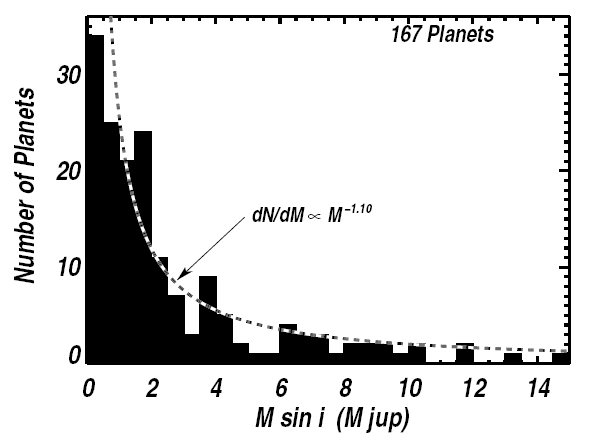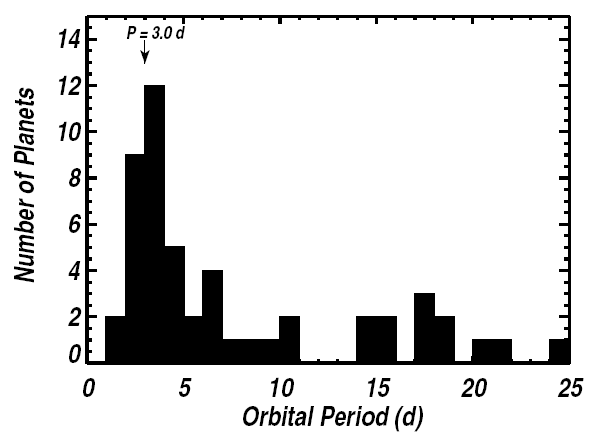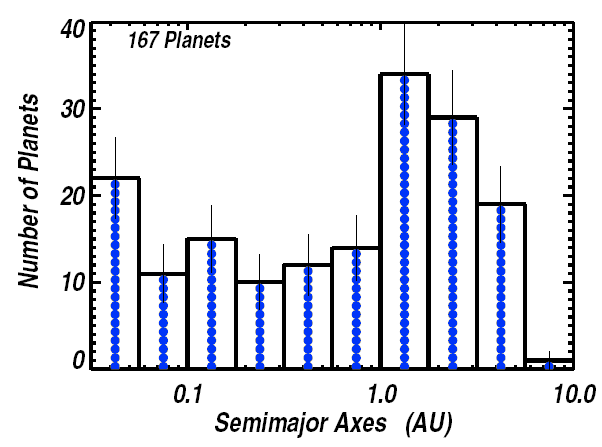Then vs. Now:
Extra-Solar Planets
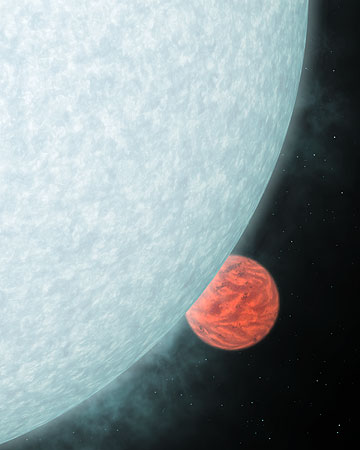
Credit: NASA/JPL-Caltech/R. Hurt (SSC)
Ten years ago the boom in finding planets around other stars was just starting. We quickly went from a few suspected planets, and planets around exotic objects, to the discovery of many Jupiter-sized planets around normal stars. Today there have been nearly 200 planets discovered around nearby stars, with the smallest less massive than Uranus. In addition, there are now prospects for discovering Earth-sized planets.
Pre-1995
In a planetary system, the planets and the parent star orbit around a common center of gravity. (In our solar system, the Sun orbits around around this common center of gravity with a speed of 12 m/s). While we cannot see the planets and their motion, we can see the star move. Astronomers have discovered planets by utilizing various techniques for detecting the motion of the star.
Before 1995, there had been searches for planets around nearby stars using a "proper motion" technique. For some nearby stars, we can see the motion of the star through space. If the star has an a planet, then the common center of gravity would move in a straight line and the star would appear to wobble along this straight line path.
Peter van de Kamp (Swarthmore College) examined the motion of Barnard's star using photographic plates taken from 1938-1981. He claimed to detect a wobble in the proper motion of Barnard's star, and deduced that there were two planets in circular orbits: one was 0.7 Jupiter masses (or "Jupiters") with an orbital period of 12 years, the other 0.5 Jupiters with period of 20 years. These results however were never independently confirmed. Van de Kamp died in 1995 standing behind his results.
In the early 1990's planets were also discovered around pulsars. The precision timing of the pulses from a pulsar allow an accurate diagnostic of the pulsar's motion. A sinusoidal variation in the arrival time of the pulse indicates the pulsar's orbital motion around an unseen body. In 1992, Aleksander Wolszczan and Dale Frail announced the discover of a planetary system around the pulsar PSR 1257+12. Subsequent observations confirmed and refined the parameters of the system: 3 planets, with masses ranging from 0.015 of the mass of the Earth to 4.3 times the mass of the Earth. The distances of the planets from the pulsar range from 0.20 to 0.46 AU. Evidence for a fourth body was discovered in 2002, but it is thought to be akin to an asteroid or a comet. To date 4 pulsars have been found to have planets.
Since 1983, the star Beta Pictoris has been known to have a dust ring around it. A void in the dust ring suggests the presence of a planet, which sweeps out the dust. Using numerical models, Francois Roques and D. Lazzaro have suggested that the planet is 20 AU from the star and moving in a nearly circular orbit. The mass of the planet is about 5 times the mass of the Earth. While observations are consistent with this model, the planet within the dust ring has not been otherwise detected.
The Planet Boom
In 1995, Michel Mayor and Didier Queloz announced their discovery of a planet orbiting the star 51 Peg. This was soon confirmed by a number of groups. The planet has mass of about half of Jupiter, lies at a distance of 0.053 AU from the star, and has a circular orbit with a period of 4.2 days. A planet this massive and this close to its parent star was certainly not what everyone was expecting!
But the technique used to detect this planet is particularly sensitive to this type of planet. It was discovered by measuring the radial velocity of the star over a long period of time. In this technique, astronomers measure the Doppler shift of the spectral lines from the star. Observing over the course of months or years, the data show a periodic shift in this Doppler velocity as the star moves toward us and away from us. From this we detect the orbital motion of the star around the center of gravity, and can deduce the mass(es) and distance of planet(s) in the system. Capable of measuring velocities down to 1 m/s, this technique favors large planets and/or planets near their parent star. This technique is effective for stars within about 150 light years from Earth.
In January 1996, Geoffrey Marcy and Paul Butler announced the discovery of planets around 70 Virginis (planet mass = 7.5 Jupiter, oribital period = 116.7 d, distance from star = 0.48 AU) and 47 Ursa Majoris (planet mass = 3 Jupiter, orbital period = 1100 days, distance from star = 2 AU). Marcy and Butler had been monitoring 100 nearby stars over the previous 8 years.
In April 1996, Marcy and Butler announced the presence of a planet around HR3522 (= 55 Cancri = Rho 1 Cancri). The planet mass is 0.8 Jupiter, with a period of 14.6 days, and a distance from the star of 0.114 AU. Later, 3 more planets were discovered around this star.
But the first multiple planet system was announced in 1999, when 3 planets were discovered around Upsilon Andromedae. The planet masses range from 0.7 to 3.95 Jupiters, and their distances from the parent star range from 0.06 to 2.54 AU.
As time has passed, more planets have been discovered by a variety of groups which had monitored a number of stars over a number of years. Since 1999, between 12 and 26 new planets have been found each year!
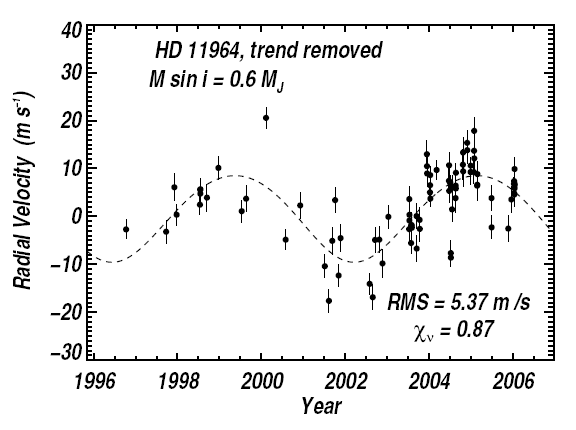
(Credit: Butler et al, 2006).
Current Census
By mid-2006, nearly 200 planets had been discovered around 160 main sequence stars. Twenty of these stars have multiple planet systems.
The parent stars have masses ranging from 0.3 - 2.0 solar masses, with distances from Earth ranging from 3.2 - 100 parsecs.
The masses of the planets range from 0.0185 Jupiter (= 5.9 times the mass of the Earth) to 23 Jupiters. The orbital periods range from 1.33 days to a few exceptional cases of 25 years. The distances from parent star range from 0.018 - 9.21 AU (for comparison, Mercury orbits at 0.39 AU from the Sun, and Saturn orbits at 9.54 AU). The orbital eccentricities range from 0.0 (circular) to 0.94.
Graphs showing the distribution of exoplanet masses, periods, and distances from parent star. Planets with distances > 3 AU have periods longer than most surveys, and thus are underrepresented. (Click on graphs for larger images.) Credit: Butler et al, 2006)
Other Searches, Other Techniques
The future of planet searches lies with finding planets of smaller sizes, down to the size of the Earth.
Transiting Planets
If circumstances are fortuitous, scientists can observe a planet crossing the disk of its parent star. In this "transit" technique, a small amount of light from the star is blocked by the planet, and astronomers observe a slight decrease in the star's intensity. By studying this dimming, astronomers can deduce the size of the planet, its density, and whether it has an atmosphere. Nine extrasolar planets have been studied in this manner.
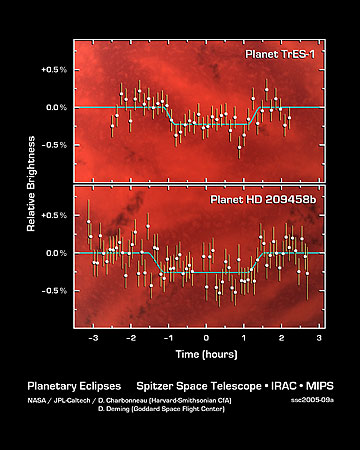
(Credit: NASA/JPL-Caltech/D. Charbonneau (Harvard-Smithsonian CfA) and NASA/JPL-Caltech/D. Deming (NASA/GSFC) Jeffrey Newman (UC Berkeley) and NASA)
Likewise, light from the planet itself can be studied when the planet passes behind its parent star. Astronomers using the Spitzer Space Telescope first used this trick on the planets HD209458b and TrES-1. First, the total infrared light of the parent star and planet is measured. Then, when the planet passes behind the star, astronomers can measure the infrared light of just the star. The difference between these two observations gives the infrared light of the planet, from which the planet's temperature can be obtained. For HD209458b, astronomers found a temperature of 1130 K, and for TrES-1 a temperature of 1060 K.
Planets via Gravitation Microlensing
Four planets have been discovered via gravitational microlensing. Gravitational microlensing occurs when light from a distant star passes by a star that is closer to us. The gravitational bending of the light also changes the intensity of the distant star light. Since the stars are in motion, the intensity varies as the closer star passes in front of the distant one. If the foreground star has a planetary companion, the planet contributes to the lensing event, and its presence can further alter the intensity. In two star systems, planets with Jupiter-like mass a few AU from the parent star were discovered. But in 2005 and 2006, planets with masses 5.5 Earths and 13 Earths were discovered, each around 3 AU from their parent star. Thus, this technique has the ability to detect Earth-mass planets using Earth-bound observatories.
10th Anniversary Articles
Additional Links
- The California and Carnegie Planet Search
- The Search for Extrasolar Planets: A Brief History
- Spitzer Measures Infrared Light from Extrasolar Planets
- ASD podcast featuring exoplanets
As part of the series, we also published a number of retrospectives on Imagine the Universe!
Publication Date: August 2006



